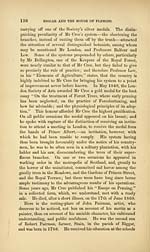Biggar and the House of Fleming
(177) Page 159
Download files
Complete book:
Individual page:
Thumbnail gallery: Grid view | List view

BIGGAR CHURCHYARD. 151
of his native place, and then went to Glasgow as an apprentice
to a draper. At the expiry of his apprenticeship, he returned
to Biggar ; and there, in the shop now occupied by Mrs George
Johnstone, commenced business on his own account. By this
time he had begun to devote his thoughts and his leisure hours
to drawing sketches from the objects around him. One of the
first portraits that he attempted, was that of his brother Rob-
ert, merchant, Biggar. He wrought at this quite stealthily.
One day he ventured to show it to his minister, the Rev. John
Brown, who had accidentally called at his shop. He made no
disclosure of the person whom he intended to represent, but
Mr Brown at once said, "That is your brother." This gratified
him exceedingly, as it showed that he could now sketch a
countenance that could be recognised. After painting a num-
ber of portraits and local scenes, he abandoned his shop at
Biggar, and repaired to Glasgow, where he took lodgings, and,
though entirely self-taught, and without patronage of any sort,
commenced business as a portrait painter. After sjDending
some years in Glasgow, he left it, and proceeded to the Scot-
tish capital, as likely to afford a better field for his exertions,
and there he fixed his head-quarters till his death. During
the summer months, he was in the habit of visiting some of
the principal towns in Scotland, and there painting portraits
of clergymen and other noted personages. The first full-
length portrait that he painted, was one of the Rev. John
Brown, Biggar; and though it is fifty years since it was exe-
cuted, the colours are still fresh, and the picture is considered
a good likeness by those who knew Mr Brown in his younger
days. At a later period, he painted another portrait of Mr
Brown, which was considered so striking a resemblance that an
engraving was taken from it. Among the portraits of other
celebrities, painted by Mr Pairman, was one of Professor Law-
son of Selkirk, which was afterwards engraved. Mr Pairman,
however, did not confine his attention to portraits; he also
painted landscapes, groups, and fancy pictures, somewhat in the
style of Wilkie. These were sent to the different exhibitions
in Edinburgh, obtained very favourable notices, and sold
readily. The last landscape that he painted, was a bridge over
the Almond, a small stream not far from Edinburgh. It is in
the possession of the widow of his brother Robert, along with
of his native place, and then went to Glasgow as an apprentice
to a draper. At the expiry of his apprenticeship, he returned
to Biggar ; and there, in the shop now occupied by Mrs George
Johnstone, commenced business on his own account. By this
time he had begun to devote his thoughts and his leisure hours
to drawing sketches from the objects around him. One of the
first portraits that he attempted, was that of his brother Rob-
ert, merchant, Biggar. He wrought at this quite stealthily.
One day he ventured to show it to his minister, the Rev. John
Brown, who had accidentally called at his shop. He made no
disclosure of the person whom he intended to represent, but
Mr Brown at once said, "That is your brother." This gratified
him exceedingly, as it showed that he could now sketch a
countenance that could be recognised. After painting a num-
ber of portraits and local scenes, he abandoned his shop at
Biggar, and repaired to Glasgow, where he took lodgings, and,
though entirely self-taught, and without patronage of any sort,
commenced business as a portrait painter. After sjDending
some years in Glasgow, he left it, and proceeded to the Scot-
tish capital, as likely to afford a better field for his exertions,
and there he fixed his head-quarters till his death. During
the summer months, he was in the habit of visiting some of
the principal towns in Scotland, and there painting portraits
of clergymen and other noted personages. The first full-
length portrait that he painted, was one of the Rev. John
Brown, Biggar; and though it is fifty years since it was exe-
cuted, the colours are still fresh, and the picture is considered
a good likeness by those who knew Mr Brown in his younger
days. At a later period, he painted another portrait of Mr
Brown, which was considered so striking a resemblance that an
engraving was taken from it. Among the portraits of other
celebrities, painted by Mr Pairman, was one of Professor Law-
son of Selkirk, which was afterwards engraved. Mr Pairman,
however, did not confine his attention to portraits; he also
painted landscapes, groups, and fancy pictures, somewhat in the
style of Wilkie. These were sent to the different exhibitions
in Edinburgh, obtained very favourable notices, and sold
readily. The last landscape that he painted, was a bridge over
the Almond, a small stream not far from Edinburgh. It is in
the possession of the widow of his brother Robert, along with
Set display mode to:
![]() Universal Viewer |
Universal Viewer | ![]() Mirador |
Large image | Transcription
Mirador |
Large image | Transcription
Images and transcriptions on this page, including medium image downloads, may be used under the Creative Commons Attribution 4.0 International Licence unless otherwise stated. ![]()
| Histories of Scottish families > Biggar and the House of Fleming > (177) Page 159 |
|---|
| Permanent URL | https://digital.nls.uk/94841406 |
|---|
| Description | A selection of almost 400 printed items relating to the history of Scottish families, mostly dating from the 19th and early 20th centuries. Includes memoirs, genealogies and clan histories, with a few produced by emigrant families. The earliest family history goes back to AD 916. |
|---|

